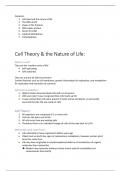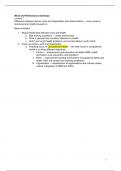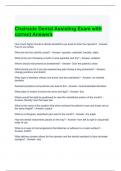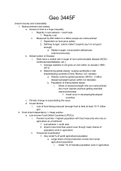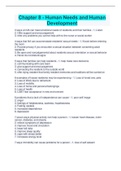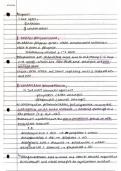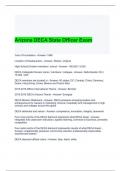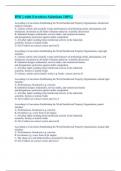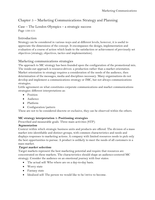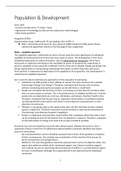1. Cell theory & the nature of life
2. The RNA world
3. Dawn of the Proteins
4. RNA makes protein
5. Desire for DNA
6. Lipids & Membranes
7. Carbohydrates
Cell Theory & the Nature of Life:
What is a cell?
They are the ‘smallest units of life’
• Self replicaLng
• Self sustained
They are around 10-100 micrometres
Contain features such as cell membrane, geneLc informaLon for replicaLon, and metabolism
for replicaLon and extracLon of nutrients
Cell science evolu1on:
1. Robert Hooke observed dead cells with no structures
2. 200 years later it was recognised that cells made up life
3. It was realised that cells were present in both animal and plants, so (correctly)
assumed that ALL life was made of cells
Cell Theory:
1. All organisms are composed of 1 or more cells
2. Cells are the basic unit of life
3. All cells arise from pre-exisLng cells
• Therefore there is an unbroken lineage of cells all the way back to LUCA
Where did LUCA come from?
• Life esLmated to have originated 4 billion years ago
• Oldest rock on Earth has signs of rudimentary metabolism, however unclear what
form this came from
• Life may have originated in sea/atmosphere/evidence of introducLon of organic
molecules from meteorites
è Modern day meteorite evidence shows amino acids & nucleoLdes (not
contaminants from Earth)
,‘Molecular soup’ & the origin of life:
= The most common theory for the origin of life, 1930s
1. HosLle condiLons on Earth (high temperatures, li]le-no oxygen, high CO2 and N)
due to volcanic acLvity and mostly oceans
2. UV light &/or lightning makes atmospheric gases react
3. This formed some precursor molecules essenLal to biology (e.g. amino acids, sugars,
nucleoLdes…) which formed and fell into the oceans
4. By chance of collision, these formed polymers via condensa6on
5. By chance, some of these polymers drive their own replicaLon
6. This quickly takes over and dominates molecular soup (leading to an exponenLal
increase in replicator)
7. This enables the polymer to randomly mutate, increasing speed of replicaLon in
some cases then being selected (making this the start of evoluLon)
3 factors that may have come first but are unsure which one:
• InformaLon carrying molecule to reproduce (DNA/RNA)
• Capacity to compartmentalise (phospholipid bilayer)
• Metabolism & energy transfer
Evidence for RNA world (RNA appeared before DNA):
Against DNA:
• DNA cannot replicate itself, it is very stable and needs protein catalysts to unwind
helix and drive synthesis
For RNA:
• RNA is single stranded and can catalyse reactions in other molecules (ribozymes)
• More recently it has been discovered that some RNA (ribozymes) catalyses the
synthesis of other RNA molecule – THEREFORE CAN SELF REPLICATE
Structure of RNA:
RNA nucleoLdes are made up of a nucleobase (A/G/U/C), a ribose, and a phosphate group.
Issues with making RNA in primordial ocean:
1. DILUTION: Conc. of RNA components in the soup would have been VERY low –
therefore: very low chance that these would combine to make an RNA nucleoLde. CatalyLc
RNA must be over 50 nucleoLdes long, so RNA synthesis is a very slow process.
2. RNA IS HIGHLY UNSTABLE IN WATER: - to form phosphodiester bond, water is
released for condensaLon. ReacLon can happen in both direcLons, far more likely to go in
hydrolysis reacLon in water as concentraLon of RNA is low and water is highly abundant.
Clay Mineral Sites – prebio1c origin for RNA?
• Warm ponds in Ethiopia contain lots of clay silicate. The clay parLcles have a high
affinity for organic molecules - this concentrates organic molecules here so increases
likelihood of meeLng to form polymers
, • Clay shrinks and expands as it gets wet and dry - this has been shown with test tubes
that RNA polymers form and favour dry condiLons.
Some issues with this:
• Wet/dry cycles are very slow, therefore evoluLon would have been very slow
• Non-pure soluLon – only ribose is used in RNA however there are many other
possible sugars present
• Unsure how RNA would have led to other features e.g. cell membrane, cell
metabolism
Membranes are self-assembling structures:
They are amphiphiles = they have two separate charges within them (hydrophobic tails &
hydrophilic heads)
Water is polar, with covalent bond between O and 2Hs. The oxygen nucleus is much larger
than the Hs. This pulls electrons towards nucleus, meaning the O becomes slightly negaLvely
charged, and the Hs are slightly posiLvely charged.
Hydrophilic - charged - therefore a]racted to water
Hydrophobic - non-charged, therefore repels water
This leads to formaLon of micelles, or bilayer sphere - lipid bilayer a]racts other
phospholipids and leads to formaLon of stable sphere with water on inside and outside - this
allows cell reacLons to take place as they all require water.
Spontaneous forma1on of membranes on early Earth:
• All fa]y acids have both charged and non-charged secLon.
• Size of cells are determined by condiLons and type of amphiphile leading to bilayer
vesicle
• Phospholipids are too complex to have formed pre-bioLcally, however simpler
amphiphiles may have self-assembled into micelles & vesicles
Forma1on of proto-cells
When a soluLon of nucleoLdes and lipids are heated, concentrated and dehydrated in lab
condiLons, micelles fuse and form vesicles – with nucleoLdes inside. Aier wejng/drying
cycles, this formed RNA like molecules inside.
è However, there is no known advantage to RNA synthesis & replicaLon to being in
a vesicle.
How does modern life solve the issue of condensing nucleo1des in presence of water?
Instead of releasing water during condensaLon, PPi (pyrophosphate) is released - this means
condensaLon is favoured as PPi is not in high concentraLon and therefore less hydrolysis
takes place and RNA is formed – as otherwise if water is released then less likely to occur
due to high exisLng water concentraLon in cells.
However, this requires energy from metabolism.
, Did life start with spontaneous metabolism?
Some parts of metabolism occur spontaneously under:
• high temp
• high pressure
• redox-acLve metals (these can donate & accept electrons).
Therefore, some of pathways of metabolism are possible to form polymers.
Where are these condi1ons on earth?
These condiLons are available in ‘alkaline smokers’ - cracks in crust allowing seawater to
meet the mantle and this generates new minerals with redox-acLve metals (e.g. iron and
nickel) through serpenLnizaLon reacLon. This reacLon also generates heat, H2, and OH-.
Here there is also high temperatures (mantle) and high pressures (bo]om of ocean).
Fe-S crystals, membranes, proton-gradients, & evolu1on
Membrane-bound proteins use proton gradients to transfer energy for
synthesis of CO2 into organic hydrocarbons. These proteins are enzymes
containing Fe-S crystals.
The same cell also has another protein to make the proton gradient and
move protons out of the cell.
• This is a very complex system to have evolved spontaneously
In the alkaline smoker vent - the interior is highly basic and has a lot of
OH-, whereas the seawater is full of CO2 and is highly acidic. This creates
a naturally occurring proton gradient.
Issues with this theory
1. Self-assembling membranes would prevent components from being able to react
with mineral in rock, prevenLng proto-metabolism catalysed by metals
2. Catalysts are required for more complex pathways of metabolism beyond
spontaneous metabolism – unsure how they would have evolved.
Fe-S crystals in the membrane may provide a mechanism for primi1ve evolu1on:
Overview: EvoluLon of cell is driven by evoluLon of catalysts.
1. Free floaLng Fe-S crystals in cell may bind to amino acids stopping the crystals from
growing further and rupturing cell.
2. If these amino acids are hydrophobic these would move into the hydrophobic
membrane - this could be an early embedded catalyst.
3. This could exploit the naturally occurring proton gradient, enabling synthesis of
organic molecules (e.g. fa]y/amino acids) from reducLon of CO2.
4. Vesicle would start growing as more fa]y acids made - eventually would split into 2
vesicles (like a soap bubble) due to biophysics
5. This may lead to selecLon of cell replicaLon of more membrane catalysts as faster
growth

